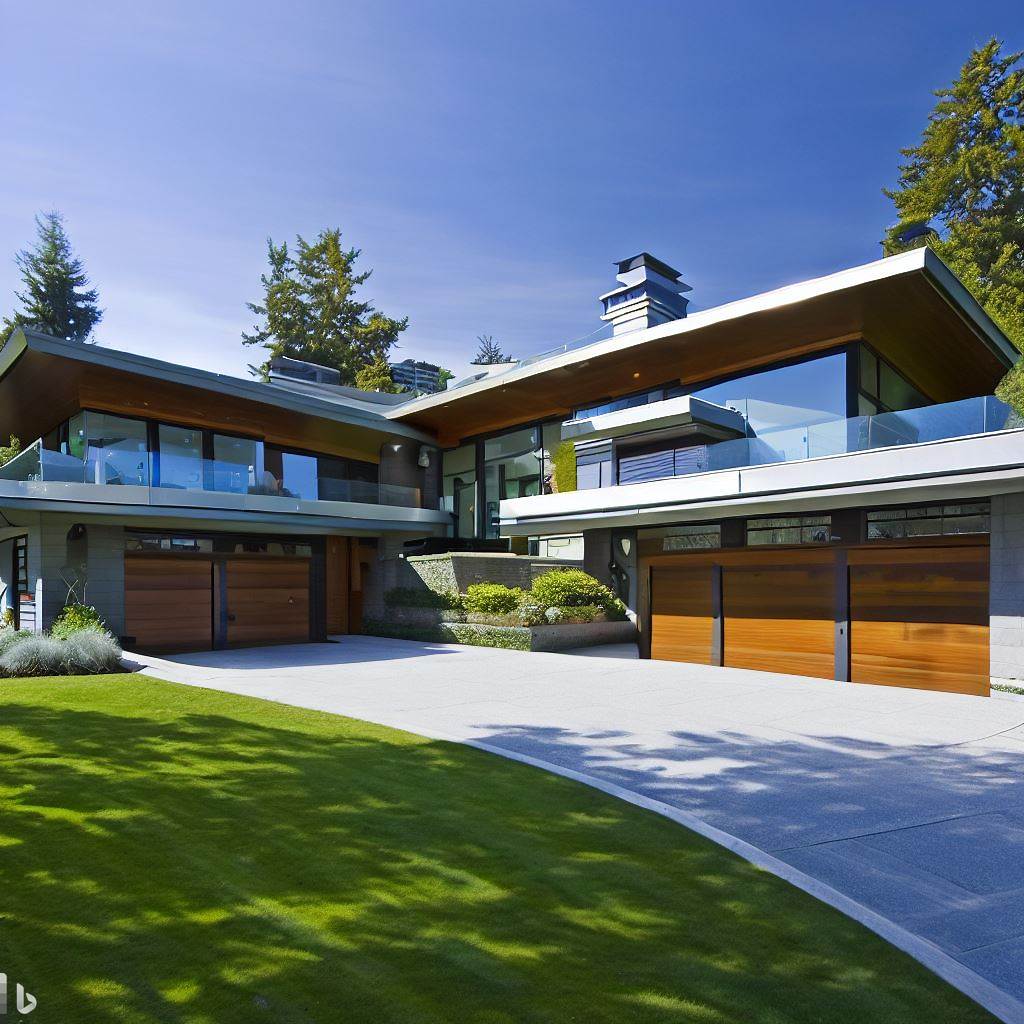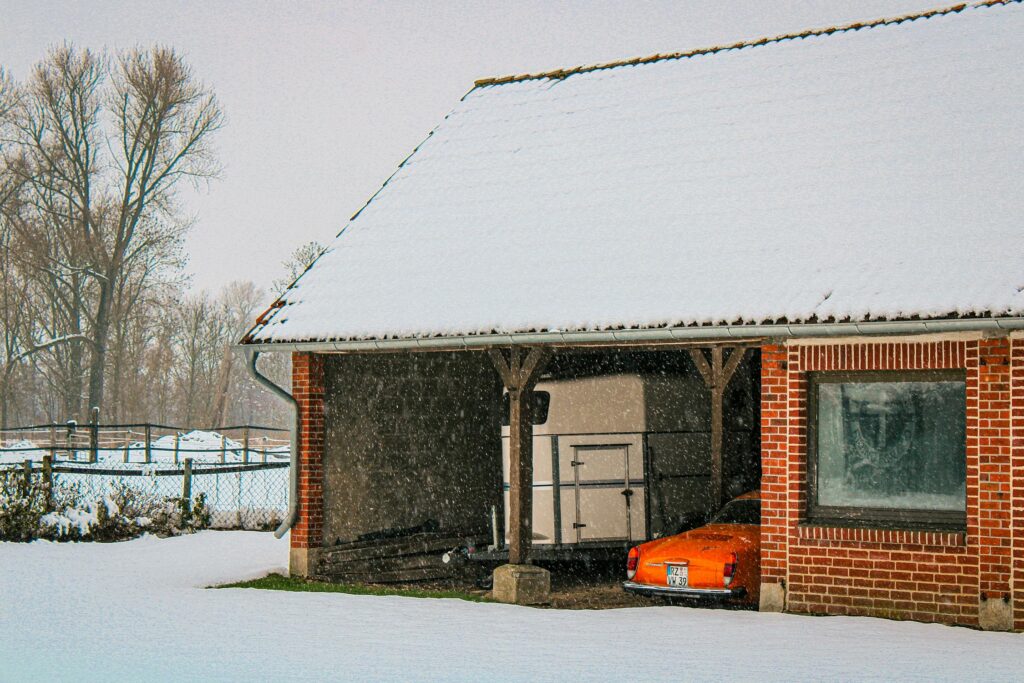Whether you need extra storage, want a vehicle safe haven, or simply hope to increase your property’s value, a well-planned and beautifully executed garage addition can be the perfect solution. Not only does it enhance your home’s functionality and curb appeal, but it also provides an opportunity to save money in the long run.
As homeowners, we understand the desire to create a space that aligns with your lifestyle and preferences without breaking the bank. Our guide will walk you through essential garage addition considerations, innovative design inspiration, and, most importantly, how to achieve your dream garage while being cost-conscious.
1: Why Consider a Garage Addition?
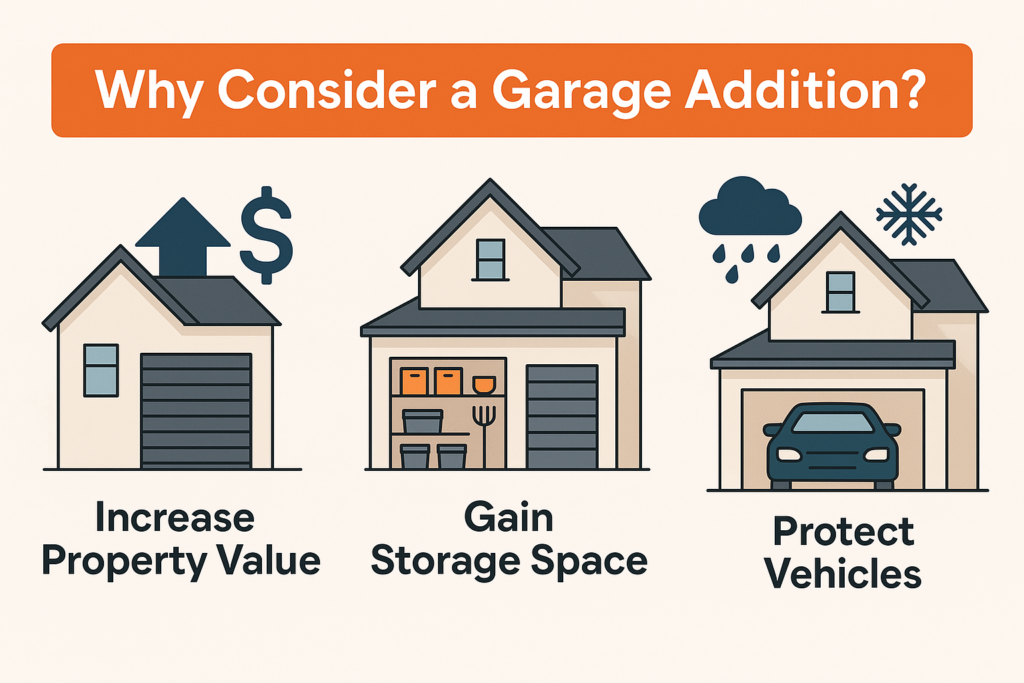
Garage additions offer myriad benefits that can significantly enhance your living experience. As a homeowner, understanding these advantages can help you make a well-informed decision about whether a garage addition is the right choice for you.
One of the primary reasons to consider a garage addition is the substantial increase in property value. Real estate experts consistently highlight that a well-designed and functional garage can significantly raise the overall worth of your home. Potential buyers often prioritize properties with ample parking and storage space, making a garage addition a strategic investment that can pay off in the future.
Beyond monetary value, a garage addition provides much-needed storage space. With modern households accumulating more possessions than ever before, having a dedicated area to keep tools, sports equipment, seasonal items, and other belongings organized is a game-changer. Say goodbye to cluttered living spaces and welcome a garage addition’s convenience and tidiness.
Protecting your vehicles from the elements is essential for maintaining their longevity and appearance. Extreme weather conditions, such as harsh sunlight, heavy rain, and snow, can cause significant damage to your car’s exterior and interior. A garage provides a sheltered environment, shielding your vehicles from these elements and potentially saving you money on maintenance and repairs in the long run.
2: Planning the Perfect Garage: Design and Functionality
Before breaking ground on your garage addition project, careful planning is essential to ensure you achieve the perfect design and functionality. This section will guide you through the crucial considerations to make your garage addition dreams a reality.
2.1 Evaluating Your Needs and Space Constraints
Determining the ideal size for your garage addition is the first step in the planning process.Assess your needs and intended use of the space. Do you need space for multiple vehicles, additional storage, and a workshop area? Consider your property and zoning restrictions that may influence the size of your garage.
2.2 Blending In: Harmonizing Architectural Styles
An aesthetically pleasing garage addition should seamlessly blend with your home’s architectural style. Choose a design that complements the overall look and feel of your property. Whether you have a modern, contemporary, traditional, or rustic-style home, numerous garage design options are available to harmonize with your house’s appearance. Strive for a cohesive look that adds value to your property and boosts curb appeal.
3: Types of Garage Additions: Attached vs. Detached
When it comes to garage additions, one of the primary decisions you’ll need to make is whether you want an attached or detached garage. Each option has its own advantages and considerations, and understanding these differences will help you choose the most suitable type for your needs.
3.1 Attached Garage: Seamless Integration and Convenience
An attached garage is physically connected to your home and shares one or more walls with the main structure. This type of garage offers several benefits, including convenient access to your home, especially during inclement weather. You can easily move belongings between the garage and your home without stepping outside, making it an excellent choice for homeowners seeking enhanced accessibility.
Additionally, an attached garage allows you to maximize your property’s footprint efficiently. If your yard has limited space, an attached garage can be a space-saving solution that leaves more room for landscaping or outdoor activities. Moreover, from an architectural standpoint, an attached garage can blend harmoniously with the design of your existing home, maintaining a cohesive appearance.
However, it’s crucial to consider potential drawbacks as well. For instance, an attached garage might limit your design options for expanding the living space within your home. Furthermore, fumes or noise from vehicles in the garage could affect the indoor air quality and ambiance of adjacent rooms.
3.2 Detached Garage: Versatility and Freedom of Design
In contrast, a detached garage stands separately from your main dwelling, providing greater versatility in design and usage. Detached garages can be constructed in various styles and sizes, allowing you to customize the structure to your preferences and specific needs.
One of the significant advantages of a detached garage is its potential to serve multiple functions. Apart from housing vehicles, it can function as a workshop, a hobby space, a home gym, or even a guest suite, depending on its size and layout. Separating from the main house provides a private retreat, making it an ideal space for noisy hobbies or creative endeavors without disturbing the household.
Another benefit of a detached garage is the architectural freedom it offers. Since it doesn’t need to blend with the existing home’s design, you can explore different styles and create a distinct focal point on your property. This can add a unique touch and elevate the overall curb appeal of your home.
However, detached garages might involve additional expenses, requiring a separate foundation and utilities. Moreover, if you reside in a region with extreme weather conditions, consider the inconvenience of walking outside to access the garage during rain, snow, or intense heat.
4: Getting Started: Permits and Building Regulations
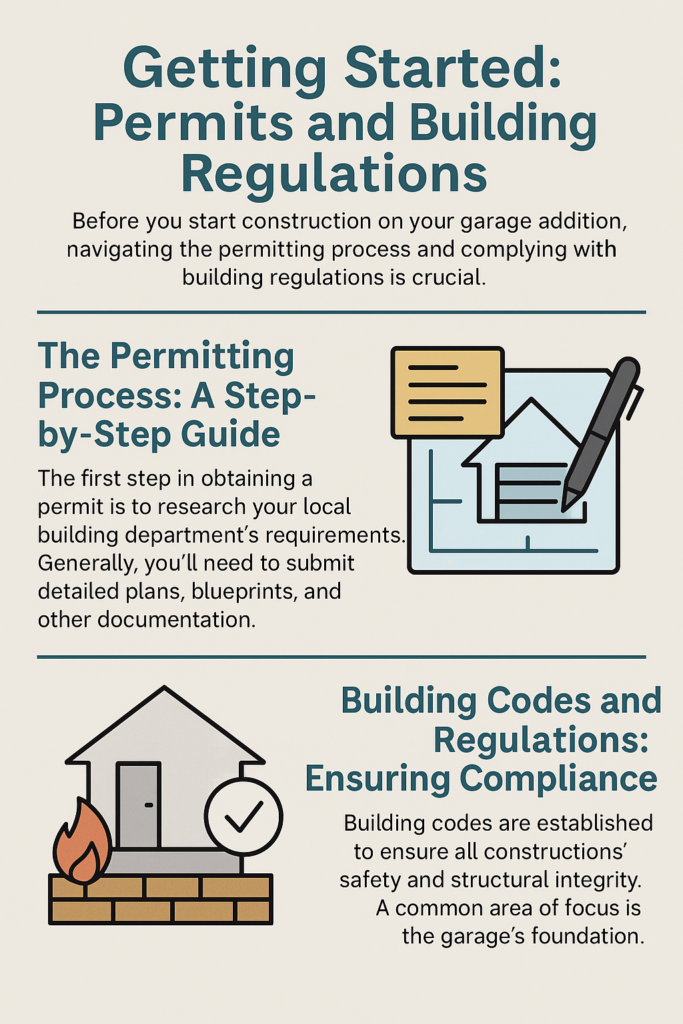
Before you start construction on your garage addition, navigating the permitting process and complying with building regulations is crucial. Understanding and adhering to these requirements will ensure a smooth and successful project while avoiding potential legal issues and costly setbacks.
4.1 The Permitting Process: A Step-by-Step Guide
The first step in obtaining a permit is to research your local building department’s requirements. Every municipality has specific rules and regulations governing garage additions, and knowing what permits are necessary for your project is essential.
Generally, you’ll need to submit detailed plans, blueprints of the proposed garage addition, and other documentation, such as property surveys, engineering reports, and energy calculations. Working with a licensed architect or contractor can streamline this process, as they are familiar with local regulations and can create plans that meet all the necessary criteria.
4.2 Building Codes and Regulations: Ensuring Compliance
Building codes are established to ensure all constructions’ safety and structural integrity. When building a garage addition, you must adhere to these codes, covering minimum ceiling height, electrical wiring standards, proper ventilation, and fire safety measures.
A common area of focus is the garage’s foundation, as it must be sturdy enough to support the structure and any additional loads it may carry. For attached garages, special attention is given to the wall shared with the main dwelling, requiring fire-resistant materials and fire-rated doors to prevent the spread of fire in case of an emergency.
By complying with building codes and regulations, you ensure the safety of your family and property and prevent potential fines and penalties that can arise from violations. Hiring licensed contractors experienced in garage additions can be invaluable in guaranteeing your project meets all the necessary requirements.
5: Building on a Budget: Cost-Saving Garage Addition Tips
Undertaking a garage addition project doesn’t have to break the bank. With careful planning and smart decision-making, you can create a functional and aesthetically pleasing garage while keeping costs in check. This section explores cost-saving strategies that will help you maximize the value of your investment.
5.1 Economical Material Choices: Quality without Compromise
Selecting the right materials is key to achieving a cost-effective garage addition without sacrificing quality and durability. Regarding the main structure, such as walls and roofing, consider materials that balance affordability and performance.
For instance, pressure-treated lumber is a budget-friendly option for framing the walls, providing strength and protection against decay. Additionally, opting for asphalt shingles for the roof can save money compared to more expensive roofing materials while offering excellent weather resistance.
While choosing the cheapest options available may be tempting, remember that durability is essential for a long-lasting garage. Cutting corners on materials might result in costly repairs or replacements down the road. Aim for a balance between affordability and quality to ensure your garage addition stands the test of time.
5.2 Smart Project Management: DIY vs. Hiring Professionals
Another aspect that can significantly impact the cost of your garage addition is your approach to managing the project. Deciding between a DIY project and hiring professionals is a crucial consideration.
If you have construction experience and the necessary skills, taking the DIY route can save you money on labor costs. However, remember that building a garage is a complex project requiring expertise in various trades, including carpentry, electrical work, and roofing. If you’re not confident in your abilities, leaving the job to experienced professionals is best.
Hiring licensed contractors is a higher upfront cost, but it can lead to significant savings in the long run. Professional contractors bring expertise, efficiency, and access to wholesale material prices, ensuring the project is completed correctly and within a reasonable timeframe. They can also navigate potential challenges and setbacks more effectively, minimizing the risk of costly mistakes.
6: Average Costs of Garage Additions
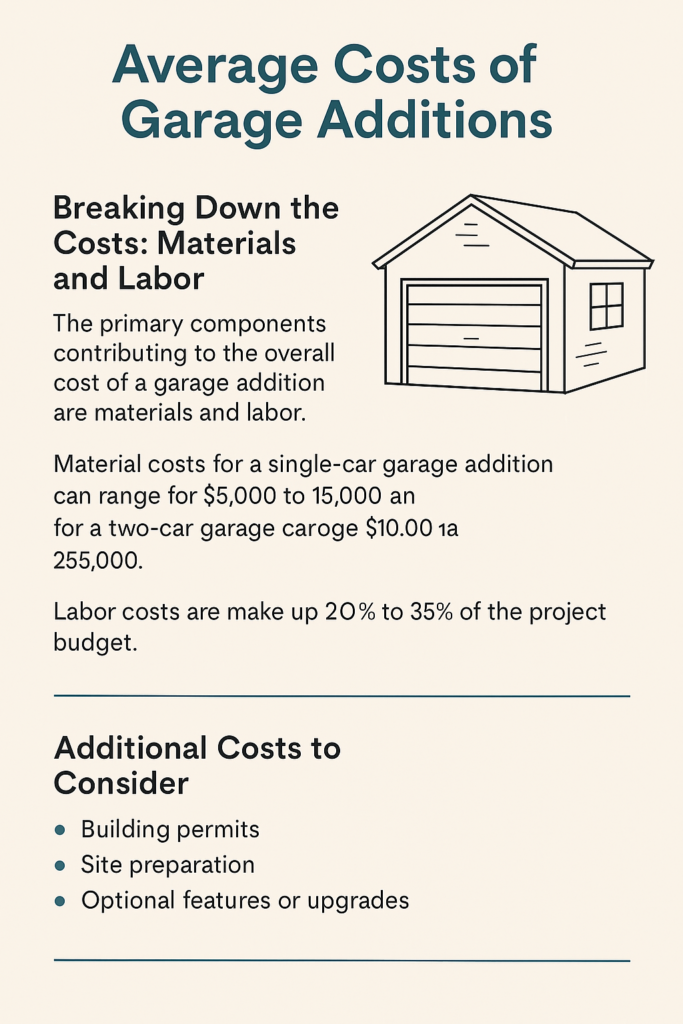
Understanding the average costs involved in garage additions will give you a realistic budget and help you plan your expenses more effectively. While the actual cost can vary based on location, size, materials, and labor, this section will provide a general overview of your expected expenses.
6.1 Breaking Down the Costs: Materials and Labor
The primary components contributing to the overall cost of a garage addition are materials and labor. The materials, including framing, roofing, siding, doors, and windows, typically account for a significant portion of the budget. Labor costs, which cover skilled tradespeople such as carpenters, electricians, and roofers, are another essential factor.
On average, the materials for a single-car garage addition can range from $5,000 to $15,000, depending on the quality and complexity of the design. For a two-car garage, the material costs can escalate to $10,000 to $25,000 or more.
Labor expenses can vary widely based on location and the level of expertise required. On average, expect labor costs to make up 20% to 35% of the total project budget. For instance, if the material costs for a single-car garage are estimated at $10,000, the labor costs could range from $2,000 to $3,500.
6.2 Additional Costs to Consider
Besides the main components, several additional costs should be factored into your budget. These include obtaining building permits, ranging from a few hundred to several thousand dollars, depending on your location and the project’s complexity.
Site preparation costs are another consideration, encompassing tasks like clearing the land, grading, and leveling. Depending on the condition of your property, these costs can vary significantly.
Moreover, consider any optional features or upgrades you may want to include in your garage addition, such as insulation, lighting fixtures, heating systems, or built-in storage solutions. While these additions can enhance the functionality and comfort of your garage, they will also influence the total project cost.
7: DIY vs. Hiring a Professional: Which is Best?
Choosing between undertaking a DIY garage addition project and hiring professional contractors can be challenging. Each approach has its own advantages and considerations that homeowners must carefully weigh.
7.1 The Appeal of DIY: Cost Savings and Personal Satisfaction
For homeowners with a background in construction or a strong desire to take on a hands-on project, a DIY garage addition can be an appealing option. One of the most significant advantages is the potential cost savings on labor expenses. You can allocate more of your budget to high-quality materials and desirable features by eliminating the need to hire contractors.
Undertaking a DIY project can also bring a sense of personal satisfaction and pride in creating a space that reflects your vision and hard work. It allows for greater control over every aspect of the construction, enabling you to customize the design to your specific needs.
However, keep in mind that a DIY garage addition requires a considerable amount of time, effort, and skill. Building a garage involves multiple tasks, from carpentry and roofing to electrical work and insulation. Unless you have experience in these areas, it’s essential to thoroughly research and prepare before embarking on the project.
7.2 Hiring Professionals: Expertise and Efficiency
On the other hand, hiring professional contractors brings invaluable expertise and efficiency to the garage addition project. Licensed contractors have the necessary knowledge and experience to handle various aspects of the construction with precision and in compliance with building codes.
Choosing professional help can lead to time savings as well. Contractors are well-versed in managing construction projects, ensuring the work progresses smoothly and on schedule. They can also handle potential challenges and unexpected situations, minimizing delays and avoiding costly mistakes.
Additionally, professionals often have access to wholesale material prices, potentially reducing the overall cost of materials compared to retail purchases.
While hiring professionals involves a higher upfront cost, it can save you both time and stress in the long run, providing you with a well-executed garage addition that meets all your requirements.
8: Garage Addition Trends and Innovations
With advancements in design and technology, garage additions have evolved to offer an array of exciting trends and innovations that cater to modern homeowners’ needs and preferences.
8.1 Eco-Friendly and Energy-Efficient Solutions
Sustainability has become a top priority in contemporary home design, and garage additions are no exception. Green building practices and energy-efficient solutions are gaining popularity, providing homeowners with eco-friendly options that reduce their environmental impact and energy consumption.
Some eco-friendly features you can incorporate into your garage addition include solar panels for power generation, energy-efficient windows and doors, and eco-friendly insulation materials. These benefit the environment and contribute to lower utility bills, offering long-term cost savings.
8.2 Multi-Functional Spaces: Beyond Parking and Storage
Garages are no longer just spaces for parking and storage; they have transformed into multi-functional areas that serve various purposes. Consider integrating your garage with versatile features, such as a designated workshop, a home gym, or a hobby area.
By maximizing the functionality of your garage, you can create a space that adapts to your lifestyle and offers extra living space without the need for extensive home renovations.
Take the Next Step to Elevate Your Home!
Congratulations! You have now gained valuable insights into garage addition ideas that can help you upgrade your home and save money. Whether you’re seeking additional storage space, protecting your vehicles, or increasing your property value, a well-planned garage addition is the perfect solution.
It’s time to take the next step and turn your garage addition dreams into reality! Plan, budget, and begin the journey towards transforming your property with a stunning and functional garage addition. Whether you embark on a DIY adventure or entrust the project to professionals, your investment will undoubtedly pay off with a space that elevates your living experience, adds value to your property, and brings a sense of pride and accomplishment.
Enjoy the journey of creating your dream garage addition and enhancing your home sweet home!
